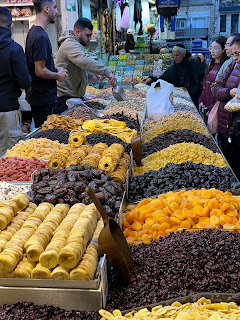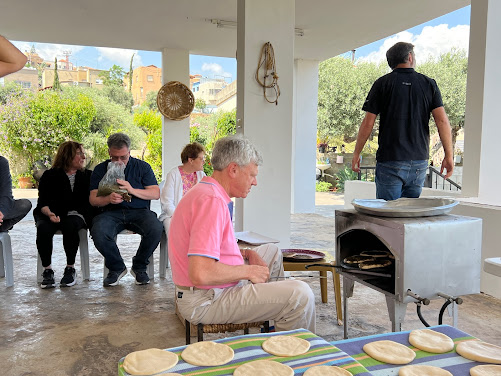Israel Day 4 – May 4, 2023
It is so easy to fall behind in keeping track of the things we are doing because there is so much
to report! And, by the end of each day, we are tired from soaking everyting in!
So I am going to pick up with Thursday, May 4.
We woke up on Thursday morning in the beautiful desert town of Mitzpe Ramon to a very
warm and sunny day. The Negev desert is in a short period called “Hamsin” – which is an Arabic
word meaning “hot spell.” While the air was dry and gentle and there was a breeze, the
contrast from Tel Aviv was amazing. No humidity, no city noise, no crowds. But because of the
Hamsin, the high temperature was forecasted to reach 90 degrees – which is very unusual for
the month of May…even in the desert!
After breakfast at the hotel, we were prepared with hats, water bottles, snacks, and cameras for
a predominantly ‘outside’ day. After all, that is what Israelis love about the desert – the beauty,
nature, interesting wildlife, unique flowers and plants, and the unique colors of the hills and
mountains. In the Negev, a lot of time is spent talking about the amount of rainfall and “how
green” it is at any given moment. Because winter in Israel has just concluded and was
adequately rainy, the desert was greener than one might imagine. While the Negev is
technically a desert, it is not the type of desert that is all sand. It is more correctly thought of as
a wilderness – which now makes more sense after our day on Thursday. Our first stop was a
beautiful park and nature preserve known as Ein Avdat. We took a magnificent walk through
some wilderness terrain, but it was obvious from the start that we were in an area where water
had to be close by. There was plenty of vegetation and trees, bushes, and flowers everywhere;
birds were chirping. The white color of the hills and terrain looked gorgeous against the crystal
clear blue sky.
We took a short walk and then out of nowhere came to a beautiful stream of water and mini-
waterfall. We learned that we were standing at the Tsin Stream – a stream of water that over
the millennia has carved out a deep and impressive canyon. We were in a magnificent oasis. We
walked over a “bridge” with the spring below us and the waterfall pouring out of a mountain
above us. Because there has been significant rainfall over the past month, there was plenty of
water all around us – and we imagined what a welcome site Ein Avdat must have been and
continues to be for those who call the Negev desert “home.” On the way back to the bus, we
were treated to something extraordinary. We looked up and into the cracks and crevices of the
canyon, and all of a sudden, we saw an ibex…and then another and another, and then several
more. Big ibex, smaller ibex, and even babies. This is the breeding season for ibex and some of
us stood and marveled at them as they blended into the background and then appeared again
as they made their way in their habitat. It was an incredibly beautiful site – and just a perfect
way to conclude our walk.
It was obvious that the temperature was rising quickly and we made a quick stop before lunch
to Sde Boker, another storied place in the Negev. Sde Boker is a Kibbutz community (cooperative,
mostly socialized village – often specializing in agriculture) that was founded in
the 1950s as a community that had at its mission the desire to escape the cities and live and
work in the beautiful desert. While nearly half of Israel is desert, it was and still is important
that the desert “blooms” – that the desert be a place in which flowers, trees, wildlife, and
Jewish life flourish. This vision of making the desert bloom was part of the Zionist dream and
one of the important objectives following the establishment of the State of Israel. One of the
most famous citizens in the history of Israel fell in love with the Negev Desert and made his
home in Sde Boker for many years – David Ben Gurion, the first Prime Minister of Israel. Ben
Gurion adored the desert and believed that the key to Jewish survival in the State of Israel
depended not upon how life was built and sustained in the cities, but rather, on how these new
Jewish communities would turn the desert into homes and farms, and communities. We walked
over to David and Paula Ben Gurion’s graves – two simple stones overlooking the magnificent
Wilderness of Tsin –the place where Moses was said to look out just before he died. While he
did not get to experience The Holy Land himself, he certainly stood close to it in the Wilderness
of Tsin and had to be as overwhelmed as we were by nature’s show of magnificence.
We got back on the bus and took a short drive to a Bedouin Village where we enjoyed an
authentic, delicious outdoor Bedouin lunch, and learned about the amazing history of the
Bedouin people - a tribal group native to the Negev – people that predate any state or national
boundaries. The Bedouins are truly wanderers of the desert; they are probably as ancient as the
land itself. We learned about their community, culture, encounters with modernity, and the
continual challenge between “tradition and change.” We watched them bake their bread on an
open fire and roast, grind and serve delicious coffee, which is part of the important Bedouin
value of welcoming guests. Like many other minority groups in Israel, the Bedouins face many
challenges but are proud of their heritage, folkways, and customs and all too happy to share
their stories with our group.
And then, it was time to learn about one of the most incredible stories about nature we had
ever heard. We took 4x4 jeeps right into the wilderness to explore what is known as “The
Ramon Crater” – in Hebrew, Machtesh Ramon. A Machtesh (it is a Hebrew word – used in all
languages to describe this geological phenomenon) is an ecological and geological phenomenon
that began millions of years ago in which an enormous land erosion formed due to several
geological events coinciding. There are only a few places in the world where all of the factors of
nature came together to create a type of crater that is unique. The Machtesh is essentially a
mountain that fell into itself through erosion and the slow movement of sand and rocks toward
the Dead Sea. What this movement left behind are multi-colored landforms caused by a
combination of minerals that have been deposited by the moving soil and rocks and the rain which in
this area is known to flash flood several times of year. All of this adds to the erosion that over
millions of years has carved out an enormous landform (our guide compared it to a ‘bathtub’)
that measures 40 km x 2-10 km and is shaped like a heart.
Because of the minerals, the water, the weather patterns, and the evolution of time, the
Machtesh is filled with medicinal plants, wildlife, colored soils of all colors – an eco-system that
is rich in resources and that is exquisite to see and understand. Machtesh Ramon, Israel’s
national treasure, is the largest Machtesh in the world and people come from all over the world
to study it and marvel at it.
After a two-hour tour of several interesting places in the Machtesh with our fabulous guide for
the day named David, we were returned via our “jeep brigade” to the hotel where we
showered and prepared for dinner (yes, another meal!!). Tired but feeling good from the
exercise, fresh air, and newfound knowledge, we ate dinner together and then got ready for one
more outdoor adventure: star-gazing in the Ramon Crater itself. So, as the sky grew dark, we
put on some warmer clothing and went back to the Ramon Crater which looks altogether
different at night. The darkness was only illuminated by the full moon and by the bonfire that
our special astronomer guide built for us. As we lay on pillows on our backs or sat in chairs
looking up at the sky, we learned about the planets, the stars, the constellations, and galaxies
and experienced the grandeur of a sky that against the quiet darkness of the desert looked like
it was filled with all kinds of sparkling and twinkling lights. While we roasted marshmallows in
the fire and drank hot tea, we also had the opportunity to view the moon from three telescopes
that our guide had set up for us. He showed us how to use the telescopes and we had a
wonderful time comparing our individual impressions of what we were looking at as we gazed
up at the sky in a place that is known for its magnificence -- both during the day and at night.
We certainly saw that the desert is a place that teems with life; a place in which nature is really
quite “busy” in so many mysterious ways. The key to the desert is being there with people who
know and understand that the wilderness should never be thoughts of as the absence of life;
rather, it is life in many different forms. You just need to respect the desert and know where to
find its hidden gifts.
















Comments
Post a Comment